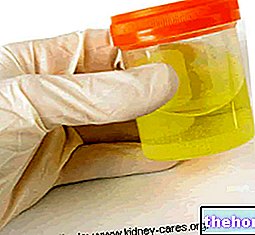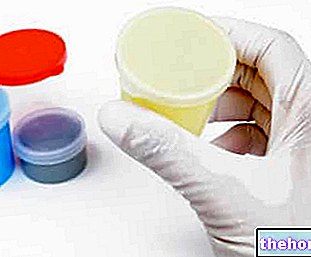Common to various pathologies, nephrotic syndrome is a clinical picture characterized by:
- presence of protein in the urine (proteinuria), which becomes foamy
- reduction in the amount of protein in the blood (dysprotidemia with hypoalbuminemia)
- appearance of generalized swelling (edema), initially in the face, then extended to other body sites, such as feet, ankles and abdomen
Often there are also:
- Hyperlipidemia (predominantly increased total cholesterol or even triglyceridemia)
- Hypercoagulability of the blood: risk of thrombo-embolism
In order to be able to speak of nephrotic syndrome, the presence of proteins in the urine must have a glomerular origin, ie be the expression of a serious alteration of the permeability of the glomerular capillary wall.
The renal glomerulus and kidney functions
The nephron is the functional unit of the kidney, that is, the smallest anatomical formation capable of carrying out all the functions to which the organ is assigned. Each of the approximately two million nephrons present in each of the two kidneys is divided into two components:
- renal or Malpinghi corpuscle (glomerulus + Bowman's capsule): responsible for filtration
- tubular system: responsible for reabsorption and secretion
which carry out three fundamental processes:
- filtration: occurs in the glomerulus, a highly specialized capillary system that allows all the small molecules of the blood to pass, opposing only the passage of larger proteins and corpuscular elements (red, white blood cells and thrombocytes). Larger proteins do not pass through physical issues, smaller ones are rejected by the presence of negative electrical charges
- reabsorption and secretion: they occur in the tubular system with the aim of reabsorbing excessively filtered substances (eg glucose, which the body cannot afford to lose in the urine) and to increase the excretion of those filtered in a manner insufficient
In the presence of nephrotic syndrome there is a loss of selectivity of the glomerular barrier both for molecular dimensions and for electric charge: consequently, important quantities of proteins are lost with the urine.
Symptoms
Edema is the most characteristic symptom and clinical sign of the nephrotic syndrome.
Subcutaneous and soft, initially localized in the periorbital area especially in the morning, the edema then tends to spread to other areas, such as the back of the feet, the presacral region and the abdomen, or to become generalized (anasarca) with ascites and pleural effusion and / or pericardial. The evolution of edema is appreciable through the daily assessment of body weight: the more this increases, the greater the accumulation of fluids in the interstitial spaces.
Foaming in the urine is a sign of proteinuria. Dark, tea-colored or coca-cola urine, on the other hand, is typical of nephritic syndrome, a condition similar to the previous one, but also characterized by the urinary loss of red blood cells.
The urinary loss of proteins, in particular of immunoglobulins, can be associated with an "increased susceptibility to infections. The patient can feel weak, asthenic, presenting cachectic only in the most serious cases and now rare.
The electrophoresis of serum proteins shows, in addition to the reduction of albumin, an increase in α2 globulins and Β globulins.

Causes and classification
Depending on its origin, the nephrotic syndrome is first of all divided into primary and secondary; in the first case it is the expression of kidney diseases, in the second of systemic diseases or in any case involving other organs besides the kidney.
Primary or primary forms of nephrotic syndrome (diagnosis is histological and therefore requires renal biopsy):
- Minimal change glomerulopathy
- Membranous glomerulonephritis
- Focal segmental glomerulosclerosis
- Membrano-proliferative glomerulonephritis
Secondary forms of nephrotic syndrome:
- Metabolic diseases: Diabetes Mellitus; Amyloidosis
- Immune diseases: Systemic lupus erythematosus; Schonlein-Henoch purpura, Polyarteritis nodosa, Sjogren's syndrome, Sarcoidosis
- Neoplasms: Leukemias, Lymphomas, Multiple Myeloma; Carcinomas (lung, stomach, colon, breast, kidney); Melanoma
- Nephro-toxicity: Gold salts, Penicillamine, Non-steroidal anti-inflammatory drugs; Lithium, Heroin
- Allergens: Insect bites; Snake bite; Antitoxin serum
- Infectious diseases
- Bacterial: post-infectious glomerulonephritis; from infected shunt; bacterial endocarditis, lue
- Viral: hepatitis B and C, HIV, Epstein-Barr, Herpes zooster
- Protozoa: malaria
- Helminths: schistosomes, filariae
- Eredo-familial: Alport syndrome, Fabry disease
- Others: Toxemia of pregnancy (Pre-eclampsia); Malignant hypertension
In young children, nephrotic syndrome is caused in 90% of cases by minimal lesion glomerulonephritis or focal and segmental glomerulosclerosis. This percentage drops to 50% in children over 10 years of age.
In adults, nephrotic syndrome is most commonly caused by membranous glomerulonephritis, followed by focal and segmental glomerulosclerosis and minimal change glomerulonephritis in incidence. About 30% of adults with nephrotic syndrome have systemic disease (diabetes mellitus, amyloidosis, systemic lupus erythematosus, or cancer, particularly of the colon or lung).
In pediatric age, nephrotic syndrome is more common among males, while in adulthood the incidence between the two sexes is uniform.
How do the symptoms and complications of nephrotic syndrome arise?
Increased wall permeability of glomerular capillaries
↓
Passage of protein into the urine (proteinuria)
↓
Reduction of plasma proteins (Hypoproteinemia or hypoprotidemia or hypoalbuminemia)
_______________________|_______________________
|
Reduction of oncotic or colloid-osmotic blood pressure
↓
Appearance of Massive Edema + Hypovolemia
↓
Reduction in renal blood flow
↓
Increased renin secretion with activation of the renin-angiotensin system and increased release of aldosterone
↓
salt and water retention and aggravation of edema
+ possible mild hypertension + increase in glomerular filtration rate
↓
wear of the nephrons due to functional overload
|
Increased compensatory synthesis of lipoproteins in the liver + urinary loss of some factors that regulate lipid metabolism
↓
Hyperlipidemia (increased plasma triglyceride, LDL and VLDL values)
↓
Lipiduria (increased concentration of lipids in the urine)
+ Increased cardiovascular risk with accelerated atherosclerosis
In the presence of nephrotic syndrome, the main protein found in the urine is albumin (selective proteinuria); however, other plasma proteins (non-selective proteinuria), such as transferrin, coagulation inhibitors and hormonal carriers may also be present to varying degrees; the loss of these elements explains the possible complications of the disease (malnutrition, infections, thrombosis, anemia, weakness). For example, in response to the reduction of plasma proteins, the liver produces a large amount of fibrinogen. If we add to this the renal loss of antithrombin III and other anticoagulant factors, a picture of hypercoagulability emerges which is frequently found in nephrotic syndrome. A complication of hypercoagulability is the possible thrombosis of the renal vein, in addition to the generalized increase in cardiovascular risk. Loss of Transferrin facilitates instead anemia, while the decrease in IgG and some factors of the Complement, like Properdin, increases sensitivity to infections. The lack of globulin that binds cholecalciferol leads to an "alteration of the metabolism of Vitamin D3 with reduced intestinal absorption of calcium and secondary hyperparathyroidism.
Therapy
The choice of therapy obviously depends on the disease of which the Nephrotic Syndrome is a consequence and expression.
Generally, the treatment involves the administration of diuretic drugs, possibly associated with the infusion of human albumin; this approach is aimed at reducing edema. Among the drugs useful for counteracting proteinuria are the ACE inhibitors, particularly indicated in case of nephrotic syndrome associated with hypertension Any alterations in lipid metabolism can be corrected by taking lipid-lowering drugs, such as statins. The increased thrombotic risk can be corrected by using anticoagulant drugs. If the nephrotic syndrome is an expression of inflammatory diseases or autoimmune aetiology, the patient can benefit from immunosuppressive drugs (cyclosporine) and steroid anti-inflammatory drugs (corticosterides).
This is associated with bed rest, the global restriction of fluid intake, the assumption of a low-sodium and low-fat diet and the abstention from drugs that can worsen the kidney damage associated with nephrotic syndrome (contrast agents, antibiotics and NSAIDs such as ibuprofen, naproxen and celecoxib).









.jpg)


















